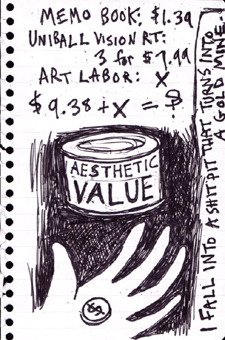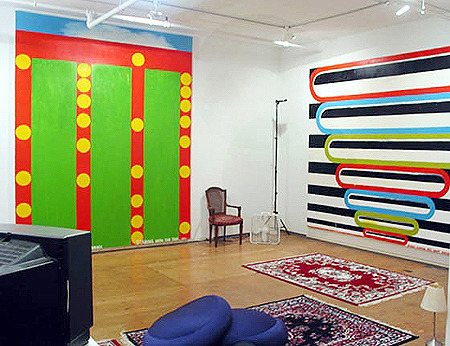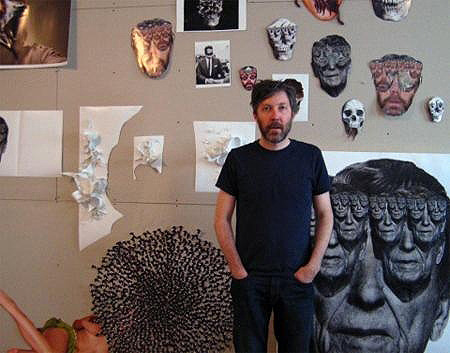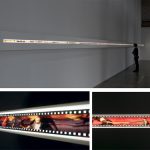The Business of Art: Living in a State of Permanent Recession?

Pages from Lawrence Swan’s graphic novel in progress, “Art Bum Comix”
We are in the midst of one of the worst economic recessions in living memory. As a result, there has been a great deal of talk about gallery closings and plummeting art market prices as the barometers of the economic affects on the art world—but what about the artists themselves?
I reached out to dozens of artists in New York and was initially surprised that many artists I spoke with seemed unfazed by the recession, though many expressed anxiety about the future. When I posted my request on Twitter for stories from the frontlines, I received a tweet from Brooklyn-based video painter Jason Varone who summed it up best, “…most artists I know live in a permanent recession.”
My conversations with artists highlighted the fact that most of them do not support themselves exclusively through their art. Their personal finances are not as deeply effected by the downturn in the art market as much as the general economic malaise that has caused lay-offs in all fields. I was struck by the general optimism shared by most artists, who are appreciative of having more time to concentrate on their work.What follows here are their stories of navigating the current economic maelstrom.
Lawrence Swan, 55, a self-described “Brooklyn-based art bum who makes art by any means necessary”
The most obvious way the recession has affected me is that I am now unemployed. My day job was with one of the major bookstore chains. I was an inventory supervisor. I worked for the company for thirteen and a half years, and it gave me the illusion of financial security while, at the same time, sapped most of my time and energy. Losing my job was a good thing, in some ways, because it forced change upon me, and I have to adapt to the new situation, as the old situation was becoming progressively more intolerable.
The art world, so-called, has been hit by the recession, and that means our ways of thinking about art and making art will change, like it or not. Do you really think that art made to adorn the homes of the rich, or made to be invested in by the rich to make them richer, is the highest form of art? Artists and dealers are now looking for new forms of distribution, new business models.
I am creating an online serial graphic novel, “Art Bum Comix.” I started it in January knowing that the country was at the beginning of a new era with a new administration in which much hope had been placed. I knew that my job had become very insecure and there was talk about the company going out of business. I had invented a character who I thought would represent me and who would give me a way to think about culture and politics in this new era. When the book is finished I will publish it in a traditionally bound form and see if there is a market for it.
Certainly the financial collapse has made it much harder to cope with the other problems we’ve had to deal with. For example, both of my parents died in the last two years. My sister and I had to sell their house, which is in Florida, just as the real estate market was plunging. It is hard to deal with all this while also coping with grief. Also, to give another example, there have been serious health issues in the family requiring hospitalization, and health insurance is expensive, so the issue of national health insurance is very important to us.
I declared myself an artist in 1973, when I was nineteen years old. America was at the beginning of some hard times brought on by the energy crisis and the wastefulness of the war in Southeast Asia, which we were losing. It’s odd that after years of people seriously discussing the possibility of a revolution, that no movement rose up to take advantage of a possible revolutionary situation when the Nixon administration collapsed under its own paranoia. Instead, what we got in 1976 was a Democratic president promising change.
Anonymous female painter, 35+, with Chelsea gallery representation
I was laid-off in mid-June. It had been a low-key job, but it was full-time. For the whole time I was there I had to negotiate the difficult trapeze act of making art, nurturing an art career, and showing up every day for work. Being cut loose was a shock and has its practical implications, but from a creative standpoint I have never been happier in my life. I have so much time to work with!
As a result of the recession, I’ve let go of some storage space, and I have bartered some art in exchange for stretchers. Otherwise I’m roaring on all cylinders. Sales stopped dead right after the downturn but one adjustment I’ve made is to produce more drawings and some smaller paintings. Hopefully that will be appealing to collectors who feel a bit constrained. The recession hasn’t impacted the aesthetics of my work that I’m aware of, except that having more time has allowed me to focus more on itl. I’m on a “residency” of sorts, an open-ended one. I’m continuing to develop my longstanding ideas. I don’t usually deal with topical issues, as such, in my work unless they fall into the parameters of the ideas I’ve been working around. Of course, I did organize an exhibition dealing with the larger concepts that connect to the recession.
I have to say that about 8 of every 10 of my friends—including artists, curators, and teaching artists—have lost their jobs in every sector of our industry: freelance graphic design, adjunct teaching, non-profit, museum, and art library jobs. The artists among them are all doing much better psychologically, since this unemployed time is almost like a gift. We have no problem knowing what to do with our time. I also hear that sales bottomed for everyone—it’s very slow.
I can’t think of any actual positive stories other than the fact that some of us, myself included, wanted to get out of our jobs (but perhaps not exactly in this way). The negatives are real and scary: how will we survive as a network until the jobs start coming back? The network will shift, some folks will leave town, and others will give up. The rest of us will figure out how to dig in and wait it out. I’m working on some projects I otherwise would not have been able to even consider starting, so that’s a good thing. But this unemployment can’t last forever; you can’t live in NYC without an income for very long.

A view of Chris Martin’s “Paintings” show at Sideshow Gallery (2005). Image courtesy Artnet.com.
Chris Martin, painter, represented by Mitchell-Innes & Nash in Chelsea
I have been very lucky to feel a lot of support and interest for what I’m doing these days. It is hard to separate the whole socio-political atmosphere from economic realities/fears amid a general atmosphere of uncertainty/fear and an emphasis on fear, but I’ve been through recession stuff before. I saw half of Soho disappear (including my own gallery John Good) in the 1990s and I seem to remember that the real artists kept on working. I don’t remember anything in terms of advice I heard so much during that period but I remember the example of friends Bill Jensen and Tom Nozkowski, who continued to work very hard and deepen their practice.
I mean all you have to do is travel to India or downtown Detroit to realize that most of us in the art world are living with plenty of food to eat, with nice shelters, free from censorship, free from terrible violence or war, etc. And we know that the planet is in serious crisis of ecological health, emotional health, spiritual health, and, frankly, there is no time to lose.
Difficult times can push artists back into solitude and deeper into what’s real. A funny thing I remember about the last recession—I went down to the cellar where I had about 100 small paintings from the previous decade and I thought since I wasn’t selling any paintings, and since I figured 100 paintings were enough to have around, that I would just work on those same 100 paintings and see if I could push them along. Out of that I got some very weird, very dense paintings.
I am very, very excited and also in crisis about what I’m doing these days, including being in dialogue with some close friends about the possibilities of painting, etc. My studio is filled with contradictory wild stuff.
Yes, I did cut down on some expenses but there seems to be plenty of junk around to work with. I believe the greatest thing for artists is time and if we have time then we can do anything with what is at hand.

Kevin Regan in his studio. Photos by Mimi Luse for BushwickBK.com
Kevin Regan, 42, artist & co-director of the newly opened Famous Accountants non-profit space in Bushwick, Brooklyn
The recession has made me more cautious. I went from working part-time as a commercial artist to working full-time. I was fortunate in that I could do this, but it’s not really what I want to be doing. I would prefer to focus on art and work only part-time. Working full-time really gets in the way of making art. I have to confess that I’m actually deeply pessimistic about the possibility of making a living from selling my art—but that’s okay! I don’t care. I want to do it anyway. I just need a minimal level of financial security. And this is what I was doing. When the economy plunged it just began to feel very irresponsible of me to be leaning on my wife as much as I was. So I stopped. I was worried about money for a little while, not because we couldn’t pay our bills, but because I was worried my wife was going to lose her job. Her support is what allowed me to work part-time. Ultimately, I guess I’m pretty lucky.
I’ve had to cut back on time. Space, supplies, and storage have not been a problem—yet. Again, I think I’ve been rather fortunate. My big frustration is not money but time. There just never seems to be enough of it. I traded time for money.
In terms of the impact on my work, my attention is much divided at the moment. This is largely because of working full-time. I’m not able to spend as much time as I would like in the studio and this is very frustrating. I’m also very frustrated that I don’t have enough time to see shows or read books.
In the midst of all this I decided to open a new art space in Bushwick, Famous Accountants, with my project partner Ellen Letcher. I have no idea what I’m doing with the space. The concept keeps morphing. When we originally decided to do it we made a list of artists we wanted to show. It was basically a year’s worth of programming but this approach seemed really boring, very administrative. I really have no interest in becoming a gallerist. I’m an artist. Creating a space is so that we can control our own destinies—and not be overly dependent on the largess of others. For me it arises out of an old punk DIY attitude (I’m talking early/mid ’80s punk). Bands like Black Flag didn’t wait around for record labels to take an interest in them. They made their own label—same story for us.
Maybe I have a funny view of art, but I tend to think it’s something you waste money on. I would like to make money off my art, not so much for the money, but so I could get shows. Don’t get me wrong, money matters, but if I was selling art I’d reinvest the profits in the art. It would enable me to increase the scale, and do nuttier things. Doing larger and crazier things is what interests me. But commercial galleries are commercial. They sell stuff. I don’t have a problem with this. I just don’t find the commercial aspect of being an artist all that interesting. I find careerism rather tedious. Resumes are not interesting texts.
Opening a space is the DIY alternative to engaging in the commercial stuff I am forced to do. I just want to do stuff and have fun.

Shai Dahan at the MOM & POPism event at Gawker Media in August 2009. Photo by Joe Russo.
Shai Dahan, 30, artist and co-founder of Abztract
Last January, in the midst of the recession, I decided to begin Abztract.com. Our plan was to introduce affordable art to the growing market of street art enthusiasts. After eleven months, the project has experienced growth and is slowly becoming profitable. I think we were lucky in a couple of ways. We introduced affordable art at the end of a wave where the majority of galleries—at least those that I’ve visited—were hiking up prices. We get a lot of people who visit galleries and want to buy art, but can’t afford the high prices.
As an artist, the recession has helped me in that it has sparked new ideas and creative thinking. I began as an artist trying to make it in the New York scene. My business partner and I noticed a trend of physical galleries shutting down, but the hunger for street art was actually growing. We asked ourselves, where are all those people going to find art by their favorite artists? That’s when we decided to create Abztract and ask artists to collaborate with us and feature them on our site. We saw tremendous growth in both visitors as well as sales.
Being surrounded by the amazing talent that is our artist collective has inspired me to think outside of my comfort zone. Abztract showed me new ways of doing things and helped me learn about things I never tried to mess with. With that, it has really developed my style and form which not only helped me to gain confidence but also produce stuff I am really happy with, even if it isn’t the same style I was used to making. Blogs have been very supportive and sites I used to only read now feature my art.
As far as the recession, I see it as a way to stay innovative. I began making customized skateboards where people had me draw their dogs on skate decks. I was doing this all through the recession, and I think at the end of the day there are still people out there who are willing to pay for something they love regardless of the economy. I think those hit hardest are the physical galleries, due to obligations like paying for the space, etc. Everything for us is online.
We have only been around since after the recession started, so I can’t wait for things to get better¯there is light at the end of the tunnel. I’m not yet financially supporting myself through Abztract and every penny we make goes back into the company. When we made our first limited-edition prints, we took everything we made and put it into making new prints of other artists which will come out in upcoming months. Both my partner and I have full-time jobs to support ourselves. We don’t depend on this for putting food on the table and I think that makes things easier for us to put passion into it all the time. There is that sense of safety that we can continue to work hard without the worry of really losing anything. Plus, once you work with the artists we collaborate with, you build friendships and suddenly you realize that you are working hard to help a friend rather than a client and that only makes you work harder and better to make sure you don’t fail.
Hrag Vartanian is the editor of Hyperallergic. His writing has appeared regularly on the Art21 blog and in the Brooklyn Rail. He also maintains a personal blog at hragv.com.





